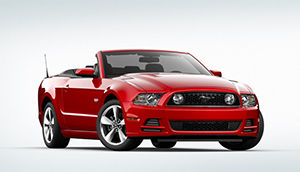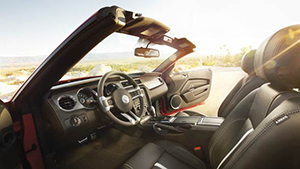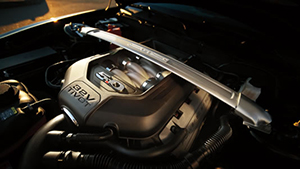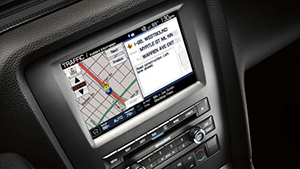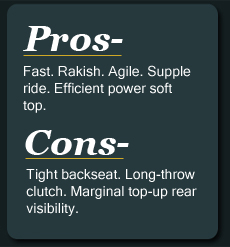Ford
Mustang GT Premium Convertible
The
2014 Ford Mustang GT convertible mixes nostalgia with sizzling
performance
Price: $39,750
The 2014 Ford Mustang GT convertible is the last of the fast
retro-classic Mustangs. It will be replaced with a significantly new
Mustang next year.
“This latest Mustang design is very respectful of its
heritage while continuing to look forward with a more powerful and
modern look,” said Darrell Behmer, Mustang chief designer.
The original Mustang debuted on April 17, 1964, although Ford called it
an ”early 1965” model. (Many call it a
“1964 ½” model.) When the redesigned
Mustang comes out next year as a 2015 model, Ford will officially
celebrate the car’s 50th anniversary—although the
2014 Mustang is actually the 50th anniversary model because of its
early 1964 introduction.
Buyers could get the first Mustang with a hot 289-cubic-inch V-8 with
271 horsepower, although most opted for lower-horsepower V-8s or
six-cylinder engines. The 2014 GT V-8 is about the same size as the
first Mustang’s V-8, but generates 420 horsepower and 390
pound-feet of neck-snapping torque.
I tested the 2014 Mustang GT Premium convertible, which is slightly
better equipped than the regular GT convertible.
The 0-60 mph time of the 2014 model is about 4.5 seconds with the
high-revving, docile engine. The quick steering is selectable with
three settings to allow a driver to choose steering effort depending on
on his or her driving style. I kept the steering in its
“standard mode,” which was just fine.
The ride is supple, although some bumps can be felt.The upcoming new
model has the Mustang’s very first independent rear
suspension for better ride and handling, but the 2014 GT’s
“solid axle” rear suspension generally does a good
job. The latest-generation Camaro, an old Mustang rival, has an
independent rear suspension.
Handling is sharp, partly because the GT’s V-8 is set way
back in the engine compartment for better weight distribution. Braking
is sure, with a progressive pedal action.
The 2014 Mustang GT’s engine is quite sophisticated, compared
to the 1964 pushrod V-8, with such items as dual overhead camshafts,
four valves per cylinder and variable camshaft timing. It’s
got an impressive 7,000 r.p.m. tachometer redline and a high 11.0:1
compression radio. The exhaust produces a genuinely sporty sound under
brisk acceleration, and dual exhaust outlets add to the car’s
racy look.
The V-8 calls for 91-octane fuel for the best performance and delivers
an estimated 15-18 miles per gallon in the city and 25-26 on highways.
My test car’s engine loafed at 70 mph when in the manual
transmission’s sixth gear. Fifth gear is good for quick 65-75
mph. passing, but fourth is even better.
Fuel tank capacity of the approximately 3,600-pound GT is 16
gallons,which should give a rough idea of the highway driving range of
this car, which is a natural born cruiser.
The clutch is moderately heavy and has a long throw. The short-throw
shifter is fun to use, although it occasionally gets notchy. You can
order a six-speed automatic transmission with a manual-shift feature,
although a car such as the GT calls out for the driver involvement of a
stick shift.
As has been the case since Day One with the Mustang, a variety of
models are offered. They range from a $22,200 coupe with a 3.7-liter
V-6 that develops no less than 305 horsepower to a supercharged
662-horsepower V-8 Shelby GT500 convertible that stickers at $59,800.
Mercy! But there’s a good chance that this model, like most
Shelby Mustangs, will become a collector’s item.
The V-6 provides an estimated 19 miles per gallon in the city and 29-31
on highways. The Shelby supercharged V-8 comes in at 15 and 24.
The 107.1-wheelbase GT looks racy with such items as functional hood
heat extractors (slots) on its hood. They’re
designed and placed to help move hot air from the V-8 compartment and
cool the engine.
The GT has a prominent grille and a hefty front end
“splitter,” which adds to the car’s
appearance but sits low and thus can be subject to damage.
Dual front and side air bags are among safety features.
A GTTrack Package is offered for the GT with a manual transmission and
a 3.73 axle. It contains an engine cooler, upgraded radiator,
performance friction brake pads and a Torsen differential for better
power delivery to the pavement. The package includes unique 19-inch
alloy wheels and summer performance tires. But it’s not the
sort of package you want for street driving.
More appropriate for road driving is an optional appearance package for
GT models. It includes black-painted side mirrors and rear
spoiler—besides body-color rear quarter window louvers. You
also get 19-inch black-painted aluminum alloy wheels. Other options
include a Brembo Brake Package for manual and automatic Mustang GT
models.
Being a convertible, without the benefit of a body stiffening hard top,
my test GT had a front strut brace arching over its engine and
additional bracing in the chassis structure to minimize body shaking
over bumps—once common with convertibles. However, there was
a little dashboard judder on a rough Chicago expressway section.
The soft top involves undoing two latches near the windshield but
automatically lowers all windows and works effectively and fairly
quickly. The interior is quiet with the top up, although the raised top
creates rear-vision problems, despite large outside mirrors. The
reverse-park-assist option thus is a good idea.
Front-seat wind buffeting is average with the top lowered.
Interior improvements include cleaner, easier-to-read instrument
cluster graphics. The appearance of the speedometer and tachometer
reminded me of those gauges in my 1967 Mustang fastback.
The front leather-trim sport seats have nice stitching and provide good
lateral support, although the driver’s power seat should move
back more if a driver prefers a pronounced upright position.
There’s a mixture of large and small climate and audio
controls. The upgraded interior looks less plasticky, and subtle blue
interior lighting highlights here and there are a classy touch,
especially at night.
Front console cupholders are nicely placed, but there’s not
much interior storage space. A 4.2-inch screen LCD
“productivity screen” lets drivers get information
related to fuel economy and vehicle performance.
There’s decent room up front but no Mustang ever has had
anything but a marginal backseat.
The trunk has a high opening, but is moderately large, and the lid
raises on struts instead of conventional hinges,which would eat into
cargo space.
Those who grew up with—or owned—earlier Mustangs
might want to take a good look at the 2014 model before the
significantly new version arrives.

